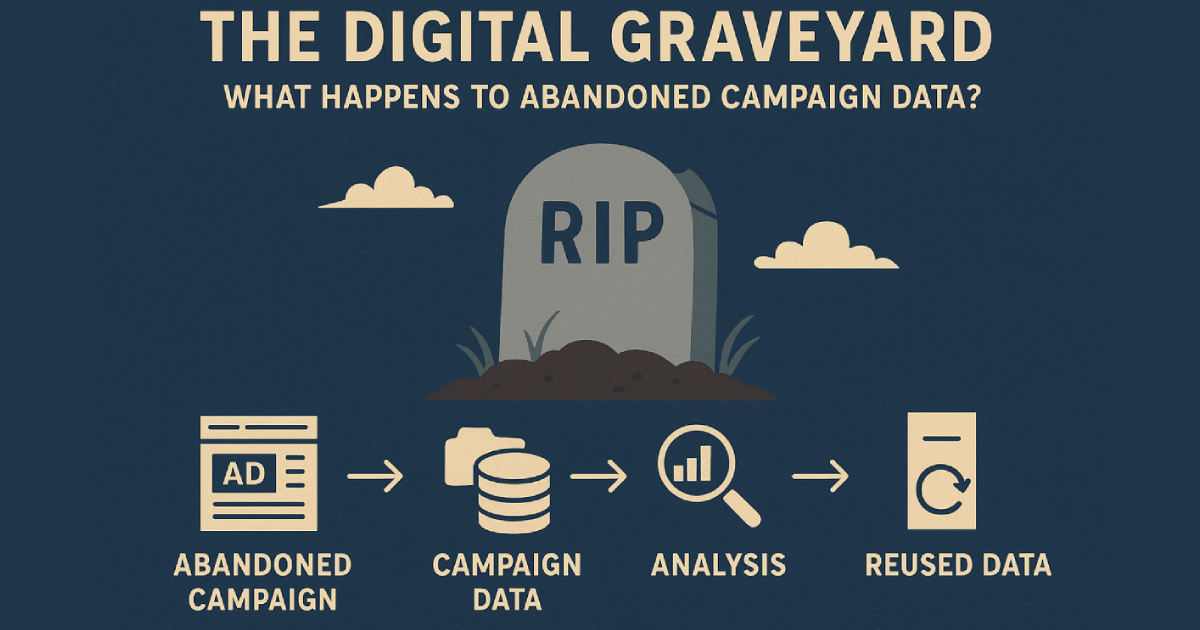The Digital Graveyard: What Happens to Abandoned Campaign Data?
Every year, businesses worldwide spend over $600 billion on digital advertising. Yet, according to Forrester Research, between 20% to 40% of ad spend is wasted because campaigns are launched, tested briefly, and then abandoned.
But here’s the uncomfortable truth most marketers don’t talk about:
That abandoned campaign data doesn’t just vanish. It either dies in silence inside ad platforms or becomes part of the larger ecosystem that shapes future marketing decisions, whether you want it to or not.
Welcome to the digital graveyard, where abandoned advertising, missing A/B testing, and unmonitored campaigns still whisper insights… If you understand how to listen.
Why It Matters
Marketers are obsessed with launching campaigns, tweaking ads, and “optimizing.” But few think about what happens after:
What happens to campaigns paused after a few days?
What about abandoned audiences that showed potential but never got scaled?
Or creatives that underperformed once but might have thrived in a different season?
Context is important since digital sites such as Google, Meta, and LinkedIn do not simply delete this information. They feed it into their algorithms, which determine how your next campaign is delivered.
Failing to capitalize on this “abandoned data” is like leaving a goldmine untapped. In fact, a 2024 HubSpot study found that organizations that used previous campaign data raised ROI by 32% compared to those that didn’t (HubSpot, 2024).
Breaking Down the Concept: The Digital Graveyard
So, what exactly is meant by the term “Digital Graveyard”?
Think of it like this:
Previously, campaigns that failed to meet KPIs were considered failures and were paused or ignored.
Today, every campaign, even if it fails, is a data set. Each click, bounce, and impression reveals something about audience psychology, timing, and platform behavior.
In other words, abandoned data is not dead; it is inactive.
Marketers can harvest hidden information from initiatives that have been buried, just as scientists do from failed studies.
Why This Is Important Right Now
Three major factors make this crucial in 2025:
1. Increasing Ad Costs
Global advertising spending is expected to reach $1 trillion by 2026 (Statista, 2025). With rising CPCs, marketers cannot afford to squander data.
2. Algorithm-driven platforms
Google Ads and Meta do not reset when you pause campaigns. Your abandoned data has an impact on quality scores, learning phases, and audience overlaps. Ignoring this is like allowing algorithms to learn from your mistakes rather than your strategies.
3. Data Privacy Restrictions
With cookies expiring and tracking getting more difficult, first-party campaign data is the new oil. Even failed efforts provide unique knowledge that no rival can obtain.
If you don’t mine the digital graveyard, you’re giving up your competitive advantage.
Step-by-Step / Actionable Insights
Here’s how to turn abandoned campaign data into growth fuel:
1. Audit Your Graveyard Monthly
- Go into Google Ads, Meta Ads Manager, or LinkedIn.
- Pull reports on campaigns you paused or killed.
- Look for patterns in impressions, demographics, and click-through rates
2. Reframe “failed” campaigns as experiments.
- Question: What worked before it failed?
- Did a certain creative hook ring true for a week before losing its appeal?
- Did CTR increase for a certain audience but drop owing to a bad landing page UX?
3. Set up a “Data Recycling Framework”
Segment insights in:
- Creative wins include hooks, graphics, and CTAs that capture attention.
- Audience Pockets: segments that were engaged but not scaled.
- Timing clues: Days/weeks when performance improved.
4. Retest with adjustments.
- Take what you have learned and repack it.
- If “Free Trial” underperformed in Q1, try “14-Day Free Access” in Q3.
5. Create a campaign memory bank.
- Save insights in Notion, Airtable, or your CRM.
- Label each campaign with “lessons learned.”
- Over time, this becomes a playbook of what works (and what doesn’t) in your niche.
Case Studies
Case Study 1: SaaS Startup Resurrects Abandoned Ad
A SaaS provider halted a Google Ads campaign targeting “remote project management tools” due to high CPC. After examining three months later, they discovered that mid-sized agencies had a threefold higher CTR. After relaunching with niche-specific copy, the ROI increased by 47% within 60 days.
Case Study 2: E-commerce Brand Discovers a Seasonal Win
An e-commerce clothes shop abandoned a summer ad set due to insufficient conversions. The creative was reused the following spring with minimal adjustments. Outcome? Sales increased by 62%, demonstrating that it wasn’t the creativity but the timing.
These instances demonstrate that data does not fail; however, techniques do.
Future Outlook: The Rise of Data Resurrection
We are entering an era in which:
AI-powered analytics solutions will automatically extract insights from abandoned campaigns.
Platforms may add “resurrection features” that recommend when to repurpose past creatives or target certain audiences.
Companies that foster data recycling cultures will save waste while gaining compounded insights year after year.
Gartner expects that by 2027, 70% of CMOs will have adopted data-recycling frameworks as normal practice.
Neglecting the digital graveyard will soon become as risky as neglecting SEO in the 2010s.
Conclusion
The digital graveyard is not a frightening place; rather, it is a library of forgotten lessons. Each abandoned campaign tells a narrative about your target audience, timing, or creative approach.
The brands that succeed in 2025 and beyond will not only launch new campaigns but will also resurrect existing ones with more effective methods.

